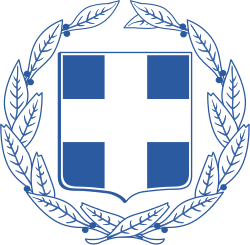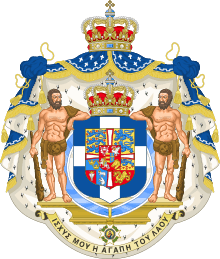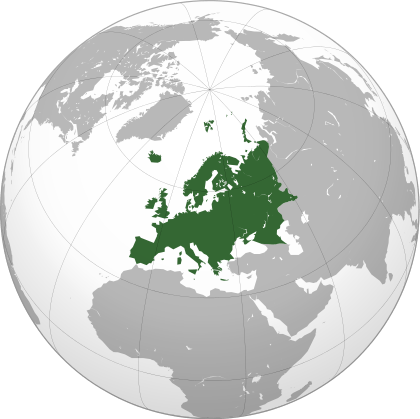Coat of arms of Greece
| Coat of arms of Greece | |
|---|---|
 | |
| Versions | |
|
Military version, used by the Greek military and security services and on the Presidential Standard | |
| Details | |
| Armiger | Hellenic Republic |
| Adopted | 1975 |
| Escutcheon | Azure, a Cross Argent |
| Other elements | The escutcheon is wholly surrounded by two laurel leaves. |
The coat of arms of Greece displays a white cross on a blue escutcheon, which is surrounded by two laurel branches.
The constitution does not specify a tincture for the branches, implying proper (i.e. green). The Greek government normally uses a design in which the laurel branches are monochrome blue. A version with golden laurel leaves is displayed by the military and on the presidential standard.
History
1832–1863: Wittelsbach dynasty
The first Greek coat of arms was introduced during the reign of the Bavarian King Otto. Based on that of the Kingdom of Bavaria, and supported by two crowned lions rampant and surmounted by the royal crown. The escutcheon of pretence was the coat of arms of Bavaria, as a symbol of the House of Wittelsbach.
This emblem was discarded upon the king's exile in 1862.
1924–1935: Second Hellenic Republic
When Greece became a republic in 1924, all external ornamentation was discarded.
1864-1924 and 1935–1973: Glücksburg dynasty
After Otto's fall, the young Prince William of Denmark was in 1864 chosen as king, and the new achievement for the coat of arms bore a strong resemblance to that of the Danish Royal Family. The escutcheon remained the same, but the dynastic arms of the Schleswig-Holstein-Sonderburg-Glücksburg family became the new escutcheon of pretence. The shield remained surmounded by the royal crown. Two new male figures were introduced as new supporters, alluding to the legendary Heracles.[1] The Order of the Redeemer was also added. The motto of the dynasty, i.e. Ἰσχύς μου ἡ ἀγάπη τοῦ λαοῦ ("People's love, my strength"), was also introduced.
This achievement remains in use by the current pretender Greek Royal Family.
1975–present
In 1973, the then-ruling military junta abolished the monarchy. 7 June 1975, the current arms was introduced. This is a restoration of the traditional arms, yet with laurel leaves being the sole external ornamentation. The government uses a stylised design by the artist Kostas Grammatopoulos.
List
| Coat of arms of the Kingdom Greece during the Wittelsbach dynasty | ||
|---|---|---|
.svg.png) | Date in use | 1833–1862 |
| Description | The coat of arms of the Kingdom of Greece during the Wittelsbach dynasty. | |
| Coat of arms of the Kingdom Greece during the Glücksburg dynasty | ||
|---|---|---|
.svg.png) | Date in use | 1863–1924 |
| Description | The coat of arms under the Glücksburg dynasty, created in 1863, used in the kingdom until 1924, when King George II was exiled. | |
| Coat of arms of the Kingdom Greece, as simplified | ||
|---|---|---|
.svg.png) | Date in use | 1863–1973 |
| Description | Also created in 1863, used as a simplified version of the main royal coat of arms. Features the light blue cross couped of Greece, without the arms of the Glücksburg dynasty. | |
| Coat of arms of Second Hellenic Republic | ||
|---|---|---|
.svg.png) | Date in use | 1924–1935 |
| Description | The coat of arms of the Second Hellenic Republic. | |
| Coat of arms of the Kingdom of Greece | ||
|---|---|---|
 | Date in use | 1936–1973 |
| Description | Created in 1936, after the restoration of the monarchy, in use until 1967, when King Constantine II was exiled, and then nominally until 1973 when the kingdom was replaced by the Hellenic Republic. The arms remains in use by the Greek Royal Family. | |
Historical, non-heraldic emblems
The first Greek national emblem was provided for by the Constitution of Epidauros of 1 January 1822 and was established by decree on 15 March of the same year. It was the shape of a blue and white circular cockade.
Since it was first established the emblem has undergone many changes in shape and in design, mainly due to changes of regime. The original Greek national emblem depicted the goddess Athena and the owl. At the time of Ioannis Kapodistrias, the first Prime Minister of modern Greece, the phoenix, the symbol of rebirth, was added.
.png)
 The seal of Greece under Governor Ioannis Kapodistrias (1828–1832) was the phoenix. The legend reads "Hellenic State", accompanied with the date "1821" (the year the Greek War of Independence began) in Greek numerals.
The seal of Greece under Governor Ioannis Kapodistrias (1828–1832) was the phoenix. The legend reads "Hellenic State", accompanied with the date "1821" (the year the Greek War of Independence began) in Greek numerals. The national coat of arms of the junta - self proclaimed "Republic" in 1973–1974.
The national coat of arms of the junta - self proclaimed "Republic" in 1973–1974.
See also
References
| Wikimedia Commons has media related to Coats of arms of Greece. |
- Law 48 (Gov. Gazette 108, issue A, dated 7.6.1975)
- ↑ From the latter, royalists in Greece were sometimes mockingly called "Ηρακλείς" ("the Heracleses").

